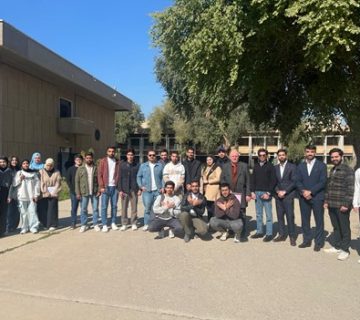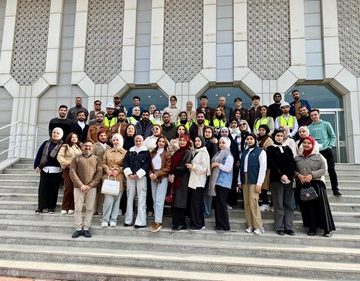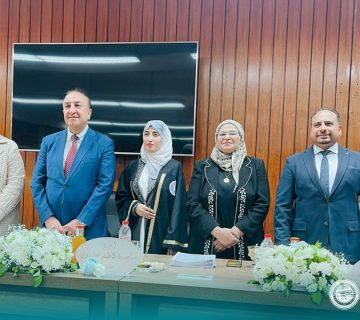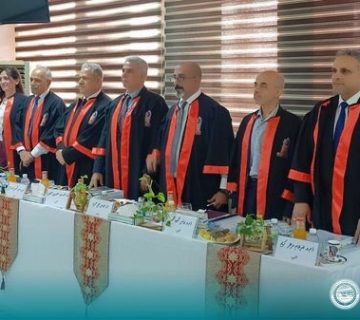The Petroleum Engineering Department at the College of Engineering, University of Baghdad, held a M.Sc. thesis examination titled:
“Estimation of Petrophysical Properties and Building A three-dimensional Geological Model for Mishrif Formation in Amara Oil Field”
By the student Salam Khalid Hasoon and supervised by Assist. Prof. Dr. Ghanim M. Farman. The examination committee consisted of Prof. Dr. Ahmed Asker Najaf Al Ahmed as Chairman and the membership of Assist. Prof. Dr. Omar Falih Hasan, and Assist. Dr. Dahlia A. Hadi. The thesis was summarized as follows:
The following are the primary goals of this study:
- Identify the Mishrif formation’s petrophysical characteristics in the Amara field.
- Identify the distribution of lithofacies in the Mishrif formation.
- Determine the Initial Oil in Place (IOIP), build a 3D geological model and distribute the petrophysical parameters.
To achieve this, the most important step in evaluating a configuration is analyzing the configuration. The economic feasibility of the reservoir is calculated by estimating the petrophysical parameters and according to the primary oil present in the location. The research was conducted on six wells in the Amara Field, which is one of the southern oil fields in Iraq. The target formation for this study is Mishrif Formation. Rock identification was applied using the Neutron-Density method and the M-N cross method, where limestone is the main stone of the Mishrif reservoir. The calculation of the volume of oil shale (VCL) was applied through single and double-log methods, and the gamma-ray method was chosen as the best in terms of accuracy, The average volume of shale in the Mishrif reservoir ranged from 6.85% to 23.46% in the wells studied. The determination of effective porosity was based on the Neutron-density method for the reservoir units and the sonic model for the non-reservoir units. The primary porosity was the mission porosity in the Mishrif reservoir, with a maximum porosity for the studied wells of 29.02%, and secondary porosity has a lesser effect. The Archie equation was chosen to estimate water saturation, where the value of RW ranges from 0.0181 to 0.0209 (ohm-m), a from 1 to 1.1, n is assumed 2, m from 1.99 to 2.59. The permeability (K) of undrilled wells was predicted through (Winland, FZI, Classical Permeability, and Empirical) methods and Winland provided the best-calculated match than the other methods used, which are FZI, the classical method, and the empirical methods. The Mishrif Formation rock unit was identified in three ways (cluster analysis, electrical rock type, and storage capacity). Cluster analysis identified three rock units (Good, Moderate, and Bad). The good rock unit has good reservoir properties and a low shale volume content (0-35%). The moderate rock unit has average reservoir properties (20-65%). The bad rock unit has a high shale volume content (40-95%) and low porosity. Electrical rock type identified four rock units (Very good, Good, Moderate, and Bad). Storage capacity confirmed the results of the electrical rock-type method. Therefore, the electrical rock type method is the best and most accurate way to identify Mishrif Formation rock units.
Petrel software (2018) is used to determine initial oil in place (OIIP) after building static 3D models through the distribution of reservoir properties. The Mishrif formation is divided into eight units (TZ1, MA, TZ2, MB1, TZ3, MB2, TZ4, MC) based on computer-processed interpretation (CPI), the final geological report, petrology, and petrophysical parameters. The general investigation showed that the units (MA, MB1) have the best quality. The facies model was built based on three integrated methods for reservoir characterization: Four hydraulic flow units (HFU) from Winland and FZI, four from DCZI, And the Lucia facies classification. Four main types of facies or rock types were identified, namely RT1, which can be defined as Grainstone representing rock characteristics with very good reservoir quality, RT2 can be defined as Packstone and represents good reservoir quality characteristics, RT3 as Wackstone and represents average reservoir quality characteristics, RT4 can be defined as Mudstone representing poor limestone characteristics. Models of porosity and water saturation were built based on the facies distribution using the Gaussian sequential simulation method for the distribution of properties. Finally, the initial amount of oil present in the reservoir is estimated by static modeling as equal to (1.375*109) STB.








